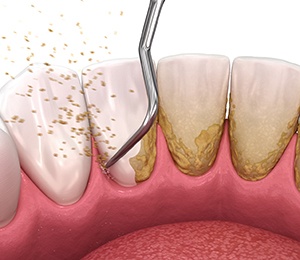 Infinity Dental Care
Infinity Dental Care
Gum Disease Treatment – Hillsboro, OR
Expert Care That Stops Gum Disease
Despite all the attention that cavities usually get, gum disease is actually the most common dental problem in the US, affecting more than 50% of the adult population. This infection attacks not only the gums, but the supporting bone underneath them as well, which can lead to redness, sensitivity, and ultimately tooth loss. Fortunately, at Infinity Dental Care, our team is ready to protect more than just your teeth. Using regular screenings and targeted therapies, we can make sure your smile’s foundation stays perfectly healthy year after year.
Why Choose Infinity Dental Care for Gum Disease Treatment?
- Gum screenings performed at every standard checkup
- Periodontal gum therapy available
- Friendly team dedicated to keeping patients comfortable
What is Periodontal (Gum) Disease?

Periodontal disease (better known as gum disease) is a bacterial infection that develops due to an accumulation of plaque and tartar along the gum line, and it’s usually the result of a lack of consistent oral hygiene. This causes the soft tissues within the mouth to become inflamed and bleed easily, and it can also lead to chronic bad breath. Left untreated, it will eventually start to break down the oral tissues, leading to gum recession and loose teeth. Gum disease is actually the number one cause of tooth loss around the world, which is why we check for it whenever a patient comes to see us!
Scaling and Root Planing

When periodontal disease is caught while it’s still in its early stages, there’s a chance that you can reverse it with regular dental cleanings and an improved oral hygiene routine. However, if the infection has stayed untreated for too long, it may require a more involved solution – namely, a deep cleaning procedure that consists of scaling and root planing. With this treatment, we can stop your gum problems from growing worse and causing larger problems like bone loss.
How Do I Know If I Need Scaling and Root Planing?

First, we’ll need to figure out exactly how severe your gum infection is. To do this, we can perform a thorough examination of your mouth (which may involve taking X-rays and other forms of digital imaging) to check for the telltale symptoms of gum disease. Signs that the infection has reached the point where scaling and root planing are needed may include the following:
- Notable gum recession that makes your teeth look longer than they used to.
- Persistent bad breath that doesn’t seem to go away when you brush your teeth or use mouthwash.
- Tender, inflamed, or bleeding gums. (These symptoms tend to be particularly noticeable when you’re brushing and flossing your teeth.)
How Does the Procedure Work?

Scaling and deep cleaning are two different steps of the deep cleaning process that, when combined, give your gums a chance to recover from infection. Scaling comes first, and it focuses on cleaning the teeth as well as the gum pockets (space between your teeth and gums) that form as a result of gum recession. During scaling, we remove any plaque and tartar that we find to prevent bacteria from doing any further harm.
The second step is scaling, which is essentially smoothing out the roots of the teeth. This is necessary because bacteria tend to have an easier time clinging to rough surfaces; a smooth tooth root is less likely to be reinfected in the future. Furthermore, the gums will have an easier time rejoining with the teeth if they have a smooth surface to reattach to.
Scaling and root planing usually takes about one or two visits, but if you have a particularly severe case of gum disease, additional appointments may be needed. We can numb your mouth to make the treatment more comfortable, and if need be, we can administer a form of dental sedation to help keep you calm.
Benefits of Scaling and Root Planing

If you receive scaling and root planing to treat your gum disease, you can enjoy several benefits, such as:
- Lowering your personal risk of losing your teeth to gum disease in the future.
- Addressing gum disease with a conservative treatment before your jawbone is permanently damaged.
- Reducing irritation, allowing you to eat comfortably while your gums heal.
- Improved oral and overall health, as correcting gum disease can also lower your risk for heart disease, diabetes, and other systemic health problems.
Periodontal Maintenance

After an initial periodontal treatment, a patient will receive ongoing care to ensure the harmful bacteria doesn’t have a chance to come back and cause further damage. Periodontal maintenance is a regimen in which a patient comes in for regular checkups and cleanings once every three to four months as opposed to every six. This enables our team to keep a closer eye on someone’s oral health and catch an infection as soon as possible.
Gum Grafting

Gum recession is a common symptom of periodontal disease in which the soft tissues of the mouth pull away from the teeth to expose the roots. The enamel around the roots is much thinner compared to the crowns, making it easier for them to develop decay that can lead to tooth loss. With a gum graft, however, we can use tissue harvested from a patient’s own mouth to restore their normal gum line, protecting their oral health while improving the look of their smile at the same time.
Periodontal FAQs

Many people underestimate the dangers of gum disease, and consequently they don’t know as much about the condition or the proper steps for treating it as they should. Dr. Kalluri has been working in the dental field for over 20 years and is always glad to have the chance to share her knowledge of periodontal health. Go ahead and contact us with your questions. Be sure to check the FAQs below to see if the answers you need are already on this page.
Is Gum Disease Reversible?
Gum disease is only reversible at its very earliest stage, gingivitis. At that point, inflammation of the gums has started, but the bone and connective tissue haven’t been affected yet, so there’s still a chance of stopping any permanent damage from being done. If we find that you have gingivitis, we can give you instructions for restoring your gum health. Usually, it’s as simple as giving your mouth a thorough cleaning and improving your oral hygiene routine. It’s important to act quickly, as it doesn’t take long for gingivitis to turn into periodontitis when it’s left untreated for long periods of time.
What are the Symptoms of Gum Disease?
At the gingivitis stage, you may notice red, tender gums or bleeding when you brush or floss. Pockets may start to form between your gums and your teeth. Once gingivitis turns into periodontitis, symptoms become more severe; pus may start seeping from the gums, and the teeth might become loose. It’s not uncommon to notice a foul taste or smell in your mouth as well. Sometimes symptoms don’t appear until the later stages of gum disease, so your best chance of catching the condition is to attend your regular checkups and call our office as soon as you notice something wrong with your mouth.
What are the Dangers of Gum Disease?
Gum disease can cause tooth loss as a result of bacteria attacking the tissues connecting the teeth to the jaw. And of course, being an infection of the gums, it can cause considerable damage to the rest of your mouth as well. Even worse, the infection can spread beyond your mouth and cause problems in other parts of your body, such as the heart or the lungs. In some cases, gum disease has even been known to make diabetes and cancer symptoms worse. As such, you should never underestimate the importance of prompt gum disease treatment.
Can I Prevent Gum Disease?
Like many oral health problems, gum disease is avoidable so long as you take the right steps. Brush and floss two times every day, and make sure that every nook and cranny in your mouth is cleaned. Stop using cigarettes or other tobacco products immediately. If you’re on any sort of medication, tell us; some drugs are known to cause gum inflammation as a side effect. Be aware of the warning signs of gum disease so that you can recognize them for what they are and act immediately when you need to.